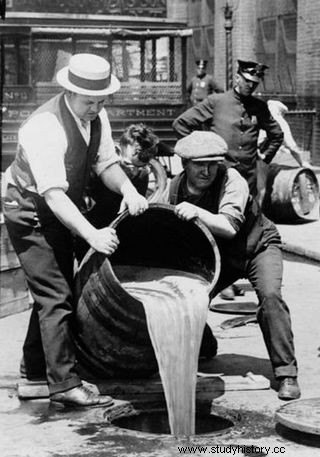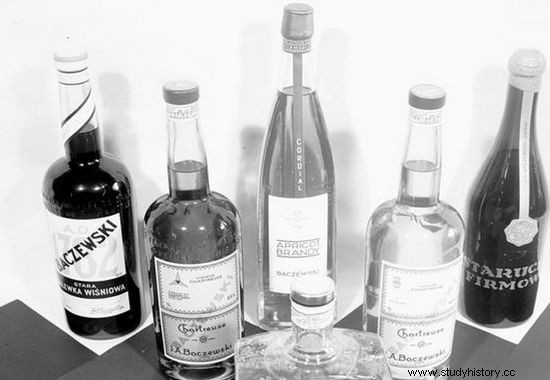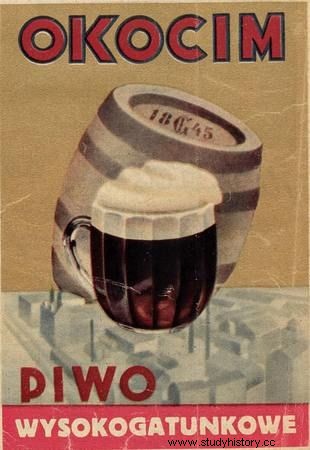strong> Prohibition is associated with the America of the 1920s, Arnold Rothstein and Al Capone. However, the idea of banning the sale of alcohol also reached the Vistula River. Few people remember that the Polish supporters of abstinence were just a few votes short of the introduction of total prohibition. Ultimately, a law was passed that was as restrictive as it generally violates
Despite the fact that the Polish-Bolshevik war was raging and the reborn state was still not glued together, the Seym devoted a lot of time to reflecting on ... selling alcohol. As early as December 1919, a group of female MPs decided to use their recently obtained political rights to end the alcohol trade.
Maria Moczydłowska, a well-known activist of the women's movement and president of the "Sobriety" Society, advocated total prohibition. From the parliamentary rostrum she argued solemnly that the fight against the terrible plague of humanity, against the poison of society it will not reduce the state's income, but on the contrary:it will increase its physical and moral condition.

Pouring illegal alcohol in the US. In the Second Polish Republic, there were those who also dreamed of prohibition on the Vistula.
Lex Moczydłowska or prohibition in Polish
Ultimately, the Polish suffragettes failed to introduce a total ban on the sale of alcoholic beverages, following the example of American and Scandinavian law. Nevertheless, from today's perspective, the law of April 23, 1920 on restrictions on the sale of alcoholic beverages (better known as "Lex Moczydłowska") appears extremely restrictive. Restrictions were imposed on all drinks with an alcohol content above 2.5%, although the minister of public health had the right to ban the sale of weaker drinks as well.
Firstly, food drinks with an alcohol content above 45% were completely excluded from the market. Secondly, there was to be one alcohol selling point for ... 2,500 inhabitants. When counting the population density in Poland, this meant that often entire communes or towns were subject to prohibition by the very law.
In addition, the inn in the countryside had to be at least 300 meters away from:churches, schools, prisons, courts, stations, railway stations, marinas for steam ships, factories employing more than 100 people and houses of prayer. As a result, it happened that there was simply no place in the whole town where he could stand.
If these restrictions were not enough, local authorities were left with the option of introducing total prohibition. To this end, it was enough to obtain a simple majority of votes in a municipal or rural referendum. A significant number of communes used this measure and by 1930 the total ban on alcohol trade was imposed on 1/10 of them.

Until World War I, distilleries in Poland were popping up like mushrooms ...
Also elsewhere it was only allowed to drink occasionally. Prohibition was in force across the country every week from 3pm Saturday to 10am Monday , on all public holidays, as well as, inter alia, during military conscription, elections, crowds of people, fairs, fairs, church fairs, pilgrimages ... In short, if someone wanted to stick to the law, it was hard to find a legal moment to drink a glass of vodka.
Final goal? Prohibition all over the country
The end of the alcohol trade was by no means the invention of a few overzealous suffragists. Anti-alcohol organizations emerged in Poland like mushrooms after rain. In addition to the already mentioned and most dynamically operating "Sobriety", there were also:the Polish Anti-Alcohol League, the Abstinence League of Railroaders, the Association of Abstinence Doctors, the Vilnius Society for Combating Alcoholism and Other Addictions, the Catholic Abstinence Union and the Polish Association of Abstinent Priests.
Many priests and doctors were in favor of sobriety. Prohibition supporters published enthusiastic articles in their own magazines. Many of them believed that a complete ban on selling alcohol was only a matter of time.
Statistics spoke in their favor. Contrary to stereotypes, Poles were one of the least drinking nations in Europe in the interwar period . In the 1920s, they consumed an average of 1 liter of pure spirit per year, which is about 8-9 times less than today. Of course, this was not only the result of legal solutions and abstinence agitation. Most Poles simply… couldn't afford to drink.
During the recession, taxed alcohol was very expensive and the widespread illegal production was obviously not included in the statistics. Social research has shown that the situation was extremely varied:in many villages there was still drunkenness and the urban population did not mind the weekend prohibition. The author of an article in "Życie Techniczna" from 1934 mocked that every Saturday from noon and Sunday, alcohol was drunk instead of in glasses - in cups .

In the times of the raging Great Depression, few Poles could afford to drink brand-name alcohols. That is why officially the consumption of spirits in the Second Polish Republic was very low.
Illegal taverns were established in America, and policemen and officials had their fingers in the alcoholic practice. For example, in 1927, in a publication published by the Section for Combating Alcoholism at the Municipal Council of the City of Łódź, the following people deplored:

Attempts to introduce prohibition in Poland eventually failed. In the 1930s, it was already possible to reach for a mug of cold beer without fear.
From various parts of the country [news arrives] about the rampant defeat of alcoholism. (...) On Saturdays and Sundays there is a rage of drunkenness in private homes; the secret inn is grown on a large scale - vodka is sold in beer halls and even shops; among drunkards there are often public servants, especially railwaymen; drunkenness rages on market days; In the period from January to May 1923, in the IX Commissariat of the Widzew district, 22 drunks were pulled out of the gutter and 14 clandestine busts were discovered.
How did it end?
The Polish adventure with prohibition lasted about the same time as the American one and had a similar ending. In 1931, the law on restrictions on the sale of alcoholic beverages liberated so much that it actually ceased to apply. It was about money, as is always the case in life. After a few years, the budget estimate of 1938 provided for an income from the spirit monopoly of 10.9% of all receipts. Nevertheless, until the outbreak of World War II, Poles drank much less than their neighbors:still less than two liters of alcohol per head.
